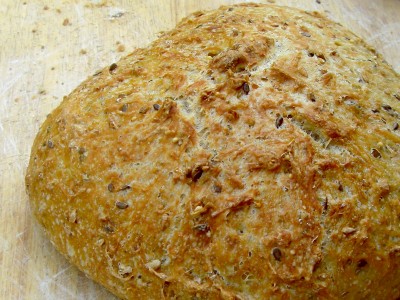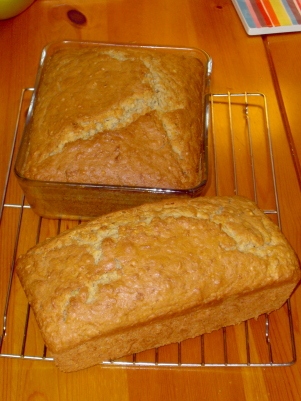Easy marrow and ginger jam recipe
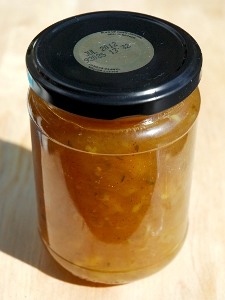 After writing up the wild plum jam recipe the last week, I realised that I hadn’t written about the super easy marrow and ginger jam I made a few weeks ago.
After writing up the wild plum jam recipe the last week, I realised that I hadn’t written about the super easy marrow and ginger jam I made a few weeks ago.
We’ve had a lot of marrows this year – more by accident than design — too many courgette plants to keep up with. I used the early ones to make my marrow cake and misc cheesy marrow bake, and I gave some of them away – but we’ve still got maybe half a dozen to use up – so I’m jamming and chutneying like there is no tomorrow.
This jam recipe is very sweet but very easy. If you’re not a fan of sweet stuff, you might prefer to use less sugar and certainly not add the crystallised ginger.
Marrow and ginger jam recipe
Wild plum/cherry plum jam recipe
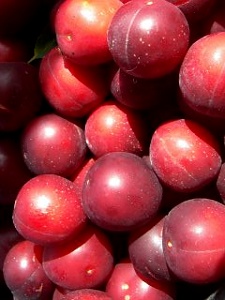 So last week, we went fishing for fruit on the mystery fruit tree outside our kitchen window. We collected 5.5kg of the plum-ish fruit, probably sacrificed as much the floor gods, and there is still a fair bit up there (albeit not terribly accessible). We’re not sure if they’re wild plum or cherry plum as everyone seems to have different opinions on what constitutes one or the other. Whatever they’re called, they’re very tart but also very sweet.
So last week, we went fishing for fruit on the mystery fruit tree outside our kitchen window. We collected 5.5kg of the plum-ish fruit, probably sacrificed as much the floor gods, and there is still a fair bit up there (albeit not terribly accessible). We’re not sure if they’re wild plum or cherry plum as everyone seems to have different opinions on what constitutes one or the other. Whatever they’re called, they’re very tart but also very sweet.
John wanted to try making plum wine (more on that another time) so I only commandeered 2kg of the harvest for our first batch of plum jam. (I’ll do another smaller jamming once he’s decided how much wine he is making tonight.)
The recipe calls for preserving sugar but granulated sugar would work just as well – preserving sugar is more expensive but the bigger crystals result in a clearer jelly. You don’t need jam sugar (sugar with added pectin) as there should already be enough pectin in the fruit.
UPDATE: Just a quick note to say that in 2011, I added a few drops of vanilla essence to the jam and it added a lovely round flavour. I can’t remember exactly how much or when (I think it was after the sugar so it wouldn’t be cooking too long, but wanted to mention it anyway, because it was delicious :)
Wild plum/Cherry plum jam recipe
Ingredients
2kg of ripe wild plums or cherry plums
1/2 pint of water
1.5kg of preserving sugar (or slightly more if you want it sweeter)
The juice of a lemon/liquid pectin if needed
Jars (we misc old food ones – it probably fills about 6 x standard 450g/16oz jars, but have a seventh on standby just in case)
Waxed paper discs
The wonder that is slow rise bread
Slow rise bread is awesome and here’s my top five reasons why.
1. Slow rise bread is really easy and, waiting aside, quick to make.
While it usually takes about 18 hours from start to finish so requires plenty of forethought if you want it for a particular meal, it only takes about 5-10 minutes of actual involvement and for me, most of that time is cleaning my mixing bowl because I’m too disorganised to do that in advance. That’s less time than it takes us to walk to the shop and back.
2. Slow rise bread tastes great.
The bread produced is not like the super fluffy, disturbingly even stuff from supermarkets; it’s heavier, chewier and the bubbles are bigger and more random. This makes it feel considerably more substantial and less like candy floss. You don’t need to eat as much to feel full.
3. Slow rise bread lasts longer than shop-bought bread.
Probably because of the heavier, chewier texture, it doesn’t feel stale anywhere near as fast as supermarket bread. Fresh-baked (rather than pre-packed) supermarket bread always seems to dry out really quickly and by the second day, needs heating in the oven/toasting to be enjoyable. Our slow rise bread is still good to eat on day three or four (although it rarely lasts that long). We waste far less bread/bread products these days.
4. Slow rise bread is cheap to make.
A loaf of the “fancy” stuff from the bread counter in a supermarket usually costs £1-ish — or more if you get their version of an artisan loaf. Even using reasonably fancy flour, my loaves cost about 30p (excluding energy for baking). I suspect I could push this down quite a lot by buying in bulk.
5. Slow rise bread saves money in other ways.
But more than just the cost of the loaf itself, we’ve saved loads of money not going to the supermarket every other day to pick up fresh bread. Because when we were there, we never just brought the bread – we’d pick up other bits and bobs, most of which were treats or other unnecessary purchases.
Easy, tasty & frugal – really, what more could you want from a loaf?
My No Knead, Slow Rise Bread Recipe
Using up the glut: Marrow cake recipe
In my previous post about saving marrow/courgette seeds, I mentioned that the marrow I had was just going from ripe to overripe. I had no particular plans to eat the marrow – we like courgettes a lot but thought, since the variety was billed as a courgette, it would be tasteless as a marrow. I was happy just using it as a seed nursery – but when I’d stripped out the seeds, it seemed a waste to throw it in the compost. If the chickens liked courgettes/marrows, I’d have given it to them but they’re strangely fussy birds so I was left with pounds and pounds of edible flesh.
I test fried a slice and judged it to be alright – not as flavourful as its younger siblings but certainly not bad. Tough skin though – edible but tough, so that had to go. I used half of it to make a cheesy-bacony comfort food bake thing (a variation on this recipe from the Indy but with mixed cheese – parmesan and jarlsberg – because that’s all we had in and also goats cheese makes me gip) – I had some on its own last night and we’ll have the rest tonight with pork chops in a tomatoey sauce. The other half, I used to make a marrow/courgette cake.
Marrow cake/courgette cake recipe
Ingredients
1 large egg (I used 2 medium ones since our girls aren’t laying truly large yet)
200g of caster sugar
100g of melted butter
1/2 tsp of vanilla extract
300g of courgette/marrow, coarse grated
300g of self-raising flour
75g of finely chopped nuts
1tsp of cinnamon
1tsp of baking powder
John’s Grandma’s marrow flower fritters recipe
I remember eating some of John’s Grandma’s marrow flower fritters at the very start of our relationship and so they always remind me of that exciting trying-new-things-with-a-new-person stage. I’d been thinking about making some with the courgette flowers we’ve had popping up over the last few weeks – when John’s mum arrived with a bag full of them last week.
While I encouraged our niece Mia to play ukelele and take photos of strange things, John and his mum whipped up a batch of fritters for lunch. Here’s the recipe – but unfortunately it’s a bit vague as it’s not been written down in their family for decades (if ever!) <- suggestions for revisions gratefully received!
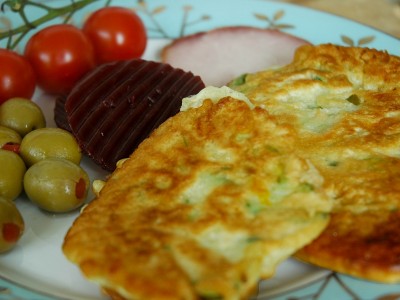
Ingredients (to make roughly 6 palm-size fritters)
Self Raising Flour about 2oz/50g per egg
The aforementioned egg or eggs
About 6 marrow flowers per egg
Some courgette/zucchini (optional but makes it more of a meal)
Pinch of salt
A little black pepper
A little water
Oil for frying
Method
Tear up the marrow flowers into pieces – size is up to you – anything from confetti size to about half the original petal size. If your plants are already fruiting, you can add a thinly sliced courgette (zucchini) to the mix too.
Mix the flour, egg, salt and water together to achieve the consistency of American pancake/drop scone batter – slightly thicker than usual British pancake batter.
Mix the flowers (and courgette, if you’re using that) into the batter.
Heat up some oil in a frying pan for shallow frying. (John & his mum used less oil when they made them and they stuck & burnt a bit.)
Drop a dollop of the batter-with-flowers into the hot oil and fry until golden brown. Flip over to cook the other side and serve immediately. John & his mum ground some more salt onto the top of the cooked fritters but that made them too salty for me – I’d have much preferred more pepper on top instead.



